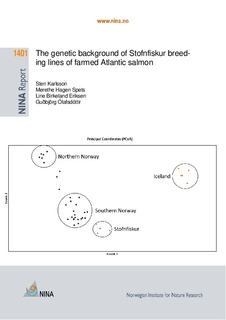The genetic background of Stofnfiskur breeding lines of farmed Atlantic salmon
Research report

View/
Date
2017Metadata
Show full item recordCollections
- NINA Rapport/NINA Report [2341]
Abstract
Karlsson, S., Spets, M.H., Eriksen, L.B & Ólafsdóttir, G. 2017. The genetic background of Stofnfiskur breeding lines of farmed Atlantic salmon - NINA Report 1401. 17 pp.
Stofnfiskur is a breeding company of Atlantic salmon located in Iceland, and delivers salmon eggs to the fish farming industry, including the Norwegian aquaculture industry. Escaped farmed salmon is considered one of the most important threats to wild salmon populations. Foreign genetic origin of the farmed salmon may possess an extra negative effect on wild salmon populations and is therefore discouraged in Norwegian legislation, and in NASCO guidelines. Documentation of the genetic origin is mandatory before approved to be used in Norwegian aquaculture. According to the information from Stofnfiskur, the Stofnfiskur breeding lines are of Norwegian origin and is a mixture of farmed salmon from the three major breeding companies in Norway: at that time Bolaks, Mowi and the National selective breeding program. The Norwegian Environment Agency has ordered a molecular genetic analysis to confirm the Norwegian origin. DNA extraction and genotyping at 96 Single Nucleotide Polymorphisms (SNPs) of fish from the Stofnfiskur breeding lines and of wild salmon from five Icelandic rivers was conducted at Matís, Icelandic Food and Biotech R&D, Iceland. We compared the genetic profiles of salmon from Stofnfiskur and the wild Icelandic salmon with the large database of Norwegian wild salmon at NINA. As a group, the Stofnfiskur salmon was genetically similar to the southern phylogenetic group in Norway and distinctively different from the Icelandic wild populations. At the individual level, 186 of 187 fish (99.5%) from Stofnfiskur assigned genetically to Norwegian rather than Icelandic wild populations, and one fish assigned with a high relative probability (98.4%) to Iceland populations. One out of 362 Icelandic wild salmon assigned to Norway rather than to Iceland, and two out of 2087 Norwegian salmon assigned to Iceland. Our analyses confirm that the salmon at Stofnfiskur is of Norwegian origin. Because Stofnfiskur is now in use in fish farms in Norway, we were also interested in to what extent we could trace this fish in events of escapes and interbreeding with wild Norwegian salmon. We used the same genetic markers and statistical analyses that are currently in use in Norway. The salmon from Stofnfiskur were not as genetically different from the Norwegian wild salmon as the current Norwegian breeding lines at the genetic markers developed to differentiate farmed from wild salmon. Unless a new set of markers are being developed including all farmed strains in Norway, genetic introgression of escaped salmon from the Stofnfiskur breeding line will lead to an underestimate of farmed genetic introgression, in events of escapes. Karlsson, S., Spets, M.H., Eriksen, L.B & Ólafsdóttir, G. 2017. The genetic background of Stofnfiskur breeding lines of farmed Atlantic salmon - NINA Report 1401. 17 pp.
Stofnfiskur er et islandsk avlsselskap for oppdrettslaks og leverer rogn til akvakulturindustrien.
Stofnfiskur leverer også rogn til Norge. Rømt oppdrettslaks vurderes som en av de alvorligste
truslene mot norsk villaks. Fremmed fylogenetisk opphav kan påføre en ekstra negativ effekt på
villaksbestander og er derfor uønsket. Før godkjent i bruk i Norge må derfor opphavet kunne
dokumenteres. I henhold til informasjon fra Stofnfiskur er deres laks av kun norsk opphav og
består av en blanding av oppdrettslaks fra Bolaks, Mowi og det nasjonale avlsprogrammet (senere
Salmobreed, Mowi og AquaGen). Miljødirektoratet har pålagt selskapet om å bekrefte dette
ved molekylærgenetiske analyser. DNA-ekstraksjon og genotyping av 96 enkeltnukleotid polymorfismer
(SNPer) for laks fra Stofnfiskur og for laks fra fem forskjellige islandske ville populasjoner
ble gjort ved Matís, Icelandic Food and Biotech R&D, på Island. Vi sammenliknet den genetiske
profilen til laksen fra Stofnfiskur og laksen fra de islandske populasjonene med en stor
genetisk database over norsk villaks ved NINA. Som gruppe var laksen fra Stofnfiskur genetisk
lik den sør-norske fylogenetiske gruppen og genetisk distinkt forskjellig fra de islandske ville
populasjonene. På individnivå ble 186 av 187 fisk (99,5 %) fra Stofnfiskur tilordnet norske populasjoner
istedenfor de islandske populasjonene og én ble tilordnet de islandske populasjonene
med en høy relativ sannsynlighet (98,4 %). Blant 362 villaks fra Island ble én tilordnet norske
populasjoner og to individer fra 2087 laks fra Norge ble tilordnet de islandske populasjonene.
Våre analyser bekrefter at det genetiske opphavet til Stofnfiskur er norsk. Siden laksen fra Stofnfiskur
allerede er i bruk i Norge, var vi interessert i å undersøke hvorvidt denne laksen kunne
spores i tilfelle rømming og innkrysning med villaks. Vi brukte de genetiske markørene og statistiske
analysene som brukes i dag for å skille mellom villaks og oppdrettslaks i Norge. Laksen fra
Stofnfiskur viste ikke like store genetiske forskjeller til norsk villaks som oppdrettslaksen fra Salmobreed,
Mowi og AquaGen. Ved å bruke de samme markørene som i dag vil derfor i tilfelle
rømming, innkrysning med villaks fra nye avlslinjer som den fra Stofnfiskur, bli underestimert.
Det vil derfor bli et behov for å utvikle nye genetiske markører som inkluderer alle nye avlslinjer.